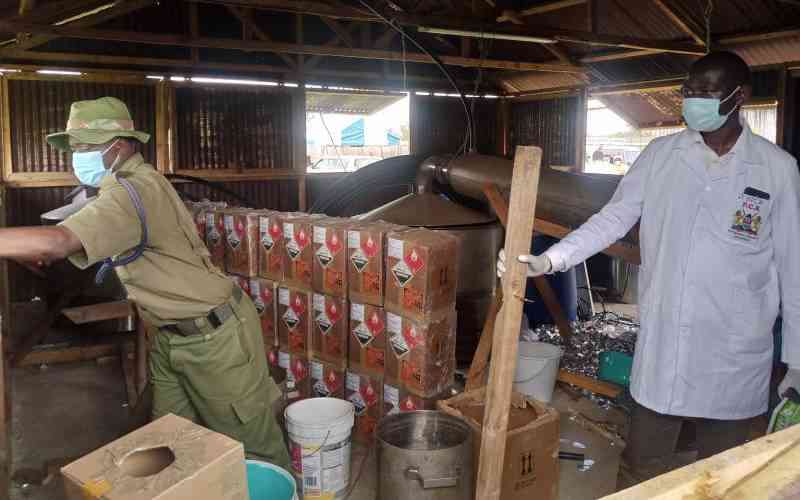 |
|
The bones are collected and crushed into fine powder that is used to filter water. [Photo: Boniface Thuku/Standard] |
Nakuru, Baringo, Kenya: The problem of excess fluoride in water has been overlooked in Nakuru and Baringo counties for a long time, although the Government and local organisations have improved access to water in both rural and urban areas.
Major water sources in the Rift Valley have a high fluoride content, above the World health Organisation’s (WHO) guidelines that recommends less than 1.5 milligrammes per litre of drinking water.
Due to high fluoride content in the drinking water, many residents have dental and even skeletal fluorosis.
This state of affairs prompted the Catholic Diocese of Nakuru (CDN) to initiate a project in 1998 to help raise awareness of the effects of drinking water with excess fluoride and at the same time introduce technologies to remove the fluoride.
“We have a problem of excess fluoride in water used for drinking and cooking in the Rift Valley. A lot of resources have been used to make water available for households in rural and urban areas but because of high fluoride, the projects have stalled,” says Joshua Waweru of the CDN Defluoridation Company.
At the Pastoral Centre in Nakuru, where the company has a laboratory for making filters, Waweru notes that water analysis conducted by the CDN in boreholes and other water sources in Nakuru and Baringo showed high levels of fluoride above the recommended WHO content.
“Some areas in Naivasha and Gilgil have up to 100 milligrammes of fluoride per litre. This means even the 60 per cent of residents who have access to piped water are likely to be consuming water with high fluoride content,” says Waweru.
It was a delight for local residents when CDN introduced Bone Char Technology, which utilised locally available raw materials and effectively reduced fluoride in drinking water.
Waweru says bone char used in fluoride filters is obtained through a painstaking and laborious process that takes over a month to produce. The company buys animal bones – the key raw material – from butcheries in Nakuru town.
The bones are then burnt in kilns at temperatures of more than 400 degrees Celsius for ten days to remove organic matter and also sterilise the bones.
“This process removes all the organic matter, leaving inorganic content of calcium and phosphate, which have the ability to absorb fluoride in water,” Waweru explains.
After this step, the charred bones are crushed into fine granules, which increases the surface area and absorption rate when used in filters.
“We sort and crush the charred bones into granules. These are then washed extensively for four days using water, sodium hydroxide and carbon dioxide-enriched water,” he adds.
The bone char granules, says Waweru, are then used to make improvised fluoride water filters for domestic, institutional and communal use.
Waweru says this technology absorbs fluoride from water as it passes through.
Stay informed. Subscribe to our newsletter
Waweru says the technology is suitable for water with 2-4 milligrammes of fluoride and can be produced at affordable costs.
If the fluoride levels in treated water go above 1.5 milligrammes per litre, then it means it is time to replace or regenerate the bone char.
Since the company’s inception, Waweru says over 3,000 households have acquired combined filters for their households while over 100 communal filters have been constructed in Nakuru and Baringo.
The combined filters cost between Sh3,500 and Sh10,000 while communal filters are constructed at a cost of between Sh700,000 and Sh1million depending on a community’s location.
Although de-fluoridation is important for providing safe drinking water in Nakuru and neighbouring counties, Nancy Wanjiku, CDN’s quality assurance manager, says the county and national governments have not supported the projects.
“Most residents in areas with high flouride water live in poverty and putting food on the table is a priority. Even though defluoridation filters are cheap, many cannot afford them,” she says.
Apart from the bone char, the company has also two other technologies that can be used to remove high fluoride levels in drinking and cooking water.
Laboratory trials have found that adding calcium and phosphorus pellets – contact precipitation – in the filters increases the life of filters by three times.
 The Standard Group Plc is a
multi-media organization with investments in media platforms spanning newspaper
print operations, television, radio broadcasting, digital and online services. The
Standard Group is recognized as a leading multi-media house in Kenya with a key
influence in matters of national and international interest.
The Standard Group Plc is a
multi-media organization with investments in media platforms spanning newspaper
print operations, television, radio broadcasting, digital and online services. The
Standard Group is recognized as a leading multi-media house in Kenya with a key
influence in matters of national and international interest.
 The Standard Group Plc is a
multi-media organization with investments in media platforms spanning newspaper
print operations, television, radio broadcasting, digital and online services. The
Standard Group is recognized as a leading multi-media house in Kenya with a key
influence in matters of national and international interest.
The Standard Group Plc is a
multi-media organization with investments in media platforms spanning newspaper
print operations, television, radio broadcasting, digital and online services. The
Standard Group is recognized as a leading multi-media house in Kenya with a key
influence in matters of national and international interest.







